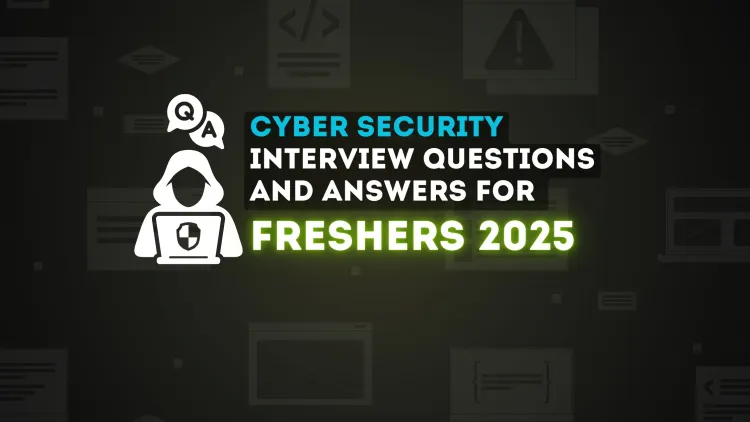50 Essential Entry-Level Cybersecurity Interview Questions and Answers
In this blog, we covered **50 essential entry-level cybersecurity interview questions and answers** to help you prepare for your upcoming job interview. The questions span key topics like **malware**, **phishing**, **firewalls**, **VPNs**, **encryption**, **penetration testing**, and more. We also discussed important cybersecurity concepts such as the **CIA Triad**, **DDoS attacks**, **multi-factor authentication**, and **hash functions**. By understanding these fundamental principles, you can demonstrate your readiness for a role in cybersecurity. This guide serves as a valuable resource to solidify your knowledge and improve your confidence as you prepare for the cybersecurity industry.

Cybersecurity is one of the most in-demand fields, with businesses prioritizing the protection of sensitive information against a growing range of digital threats. If you're preparing for an entry-level cybersecurity interview, it's important to understand the key topics and concepts that interviewers may test. In this blog, we'll explore 50 essential entry-level cybersecurity interview questions and answers to help you prepare effectively.
What is Cybersecurity?
Answer:
Cybersecurity refers to the practices, processes, and technologies designed to protect systems, networks, and data from unauthorized access, attacks, or damage. It encompasses everything from securing sensitive information to defending against cyber threats such as malware, hacking attempts, and data breaches.
What are the Different Types of Cybersecurity Threats?
Answer:
There are several types of cybersecurity threats, including:
- Malware: Malicious software such as viruses, worms, and ransomware designed to damage or disrupt systems.
- Phishing: Fraudulent attempts to steal sensitive information by impersonating trusted entities.
- DDoS Attacks: Distributed Denial-of-Service attacks aim to overwhelm systems and make them unavailable.
- Man-in-the-Middle (MITM): Attacks that intercept and alter communication between two parties.
- SQL Injection: Malicious code injected into a database to manipulate or steal information.
What is a Firewall and How Does It Work?
Answer:
A firewall is a network security system that monitors and controls incoming and outgoing traffic. It filters traffic based on predetermined security rules, blocking malicious or unauthorized access while allowing legitimate traffic to pass through. Firewalls can be hardware-based or software-based.
What is the Difference Between Symmetric and Asymmetric Encryption?
Answer:
- Symmetric Encryption: This method uses a single key for both encryption and decryption. It is faster but requires securely managing the shared key.
- Asymmetric Encryption: This method uses a pair of keys, a public key for encryption and a private key for decryption. Asymmetric encryption is more secure but slower due to the complexity of the process.
What is the CIA Triad in Cybersecurity?
Answer:
The CIA Triad is the foundational model for cybersecurity, consisting of three principles:
- Confidentiality: Ensuring that data is only accessible to authorized individuals or systems.
- Integrity: Ensuring the accuracy and reliability of data by preventing unauthorized modification.
- Availability: Ensuring that data and systems are accessible to authorized users when needed.
What is Malware? Can You Explain Different Types of Malware?
Answer:
Malware is software specifically designed to harm or exploit computer systems or networks. Common types of malware include:
- Viruses: Programs that attach themselves to other files and replicate when executed.
- Worms: Self-replicating programs that spread across networks without needing to attach to files.
- Ransomware: Malware that encrypts files and demands a ransom for their release.
- Spyware: Software that secretly monitors and collects user information without consent.
What is Phishing and How Does It Work?
Answer:
Phishing is a type of social engineering attack where attackers impersonate legitimate organizations or individuals to deceive victims into revealing sensitive information such as usernames, passwords, or credit card details. Phishing can occur through emails, phone calls, or websites that appear authentic.
What is a VPN and Why is it Important?
Answer:
A VPN (Virtual Private Network) is a service that creates a secure, encrypted connection between your device and the internet. It hides your IP address and encrypts your data, making it essential for protecting privacy and ensuring safe browsing on unsecured networks like public Wi-Fi.
What is the Difference Between IDS and IPS?
Answer:
- IDS (Intrusion Detection System): Monitors network traffic and alerts administrators when suspicious activities or security breaches are detected. It does not block threats, only identifies them.
- IPS (Intrusion Prevention System): Similar to IDS but takes it a step further by actively blocking or preventing potential threats in real-time.
What is SQL Injection?
Answer:
SQL Injection is a type of attack where malicious SQL queries are injected into input fields (such as search boxes or login forms) in order to manipulate or access the backend database. It is a common vulnerability in web applications that do not properly sanitize user inputs.
What is HTTP vs HTTPS?
Answer:
- HTTP (HyperText Transfer Protocol) is the basic protocol used for communication over the internet. However, it is not encrypted and can expose data to interception.
- HTTPS (HyperText Transfer Protocol Secure) uses SSL/TLS encryption to secure data transmitted between the user’s browser and the web server, making it more secure than HTTP.
What is Social Engineering?
Answer:
Social engineering is the manipulation of individuals into divulging confidential information, often by exploiting psychological factors such as trust or fear. It’s a non-technical attack that relies on human error rather than system vulnerabilities.
What is an Endpoint in Cybersecurity?
Answer:
An endpoint refers to any device that connects to a network, such as laptops, smartphones, tablets, and IoT devices. Securing endpoints is crucial, as they can serve as entry points for cyberattacks.
What is the Difference Between DoS and DDoS Attacks?
Answer:
- DoS (Denial-of-Service) attacks attempt to overwhelm a system or network with traffic to make it unavailable.
- DDoS (Distributed Denial-of-Service) attacks are similar, but involve multiple systems working together to amplify the attack, making it more difficult to mitigate.
What is the Role of Encryption in Cybersecurity?
Answer:
Encryption is the process of converting plaintext data into unreadable ciphertext to protect it from unauthorized access. It ensures the confidentiality and integrity of sensitive information during transmission or storage.
What is a Hash Function and Why is it Important?
Answer:
A hash function is a mathematical algorithm that converts input data into a fixed-size string of characters, typically a hash value. Hash functions are important for ensuring data integrity, as even a small change in the input results in a completely different hash.
What is the Principle of Least Privilege?
Answer:
The Principle of Least Privilege is a security concept that states that users and systems should be given the minimum level of access necessary to perform their tasks. By limiting permissions, you reduce the risk of unauthorized access and potential damage.
What is a DDoS Attack and How Do You Mitigate It?
Answer:
A DDoS attack (Distributed Denial-of-Service) involves overwhelming a system with traffic from multiple sources, rendering it unavailable to legitimate users. Mitigation strategies include rate limiting, using anti-DDoS software, and deploying additional resources to handle increased traffic.
What is Penetration Testing?
Answer:
Penetration testing (or ethical hacking) involves simulating a cyberattack on a system, network, or application to identify vulnerabilities before malicious attackers can exploit them. It helps organizations strengthen their security posture.
What is Multi-Factor Authentication (MFA)?
Answer:
Multi-Factor Authentication (MFA) is a security process that requires users to provide two or more forms of authentication to verify their identity. This can include something they know (password), something they have (a smartphone or hardware token), or something they are (fingerprint or facial recognition).
What is a Proxy Server?
Answer:
A proxy server acts as an intermediary between a client and a server. It forwards client requests to the server, helping to mask the client’s IP address and adding a layer of security by filtering content and preventing direct access to internal networks.
What is a Security Incident Response Plan?
Answer:
A security incident response plan outlines the procedures an organization follows when a security breach occurs. It includes steps for detecting, containing, and recovering from incidents, as well as communication and documentation guidelines.
What is a Botnet?
Answer:
A botnet is a network of compromised computers or devices that are controlled by cybercriminals to carry out malicious activities, such as launching DDoS attacks, spreading malware, or stealing sensitive information.
What is the Role of a SIEM System in Cybersecurity?
Answer:
A SIEM (Security Information and Event Management) system collects and analyzes data from various sources within a network to detect, monitor, and respond to security threats in real-time. It provides centralized logging, event correlation, and alerts to enhance the organization’s security posture.
Conclusion
In preparation for your entry-level cybersecurity interview, these 50 questions and answers will equip you with the knowledge and confidence to excel. Understanding the basics of network security, encryption, and incident response is essential to your success in the field. Remember to stay updated with the latest cybersecurity trends and best practices to remain competitive in this dynamic industry.
FAQs
-
What is Cybersecurity?
Cybersecurity protects systems and data from digital attacks, ensuring confidentiality, integrity, and availability. -
What is a Firewall?
A firewall monitors and controls incoming and outgoing network traffic to prevent unauthorized access. -
What is Multi-Factor Authentication?
MFA requires two or more forms of verification to enhance security during login. -
What is a DDoS Attack?
A Distributed Denial-of-Service attack floods a network or server with traffic, making it unavailable. -
What is Phishing?
Phishing is a technique used by cybercriminals to deceive individuals into revealing sensitive information. -
What is Encryption?
Encryption converts data into a secure format to prevent unauthorized access. -
What is a Hash Function?
A hash function generates a fixed-length value from input data, used to verify its integrity. -
What is SQL Injection?
SQL injection exploits vulnerabilities in a web application’s database to execute malicious commands. -
What is an Endpoint?
An endpoint is any device connected to a network, such as a computer, smartphone, or server. -
What is Penetration Testing?
Penetration testing simulates a cyberattack to identify vulnerabilities in systems and applications.











![Top 10 Ethical Hackers in the World [2025]](https://www.webasha.com/blog/uploads/images/202408/image_100x75_66c2f983c207b.webp)



![[2025] Top 100+ VAPT Interview Questions and Answers](https://www.webasha.com/blog/uploads/images/image_100x75_6512b1e4b64f7.jpg)







